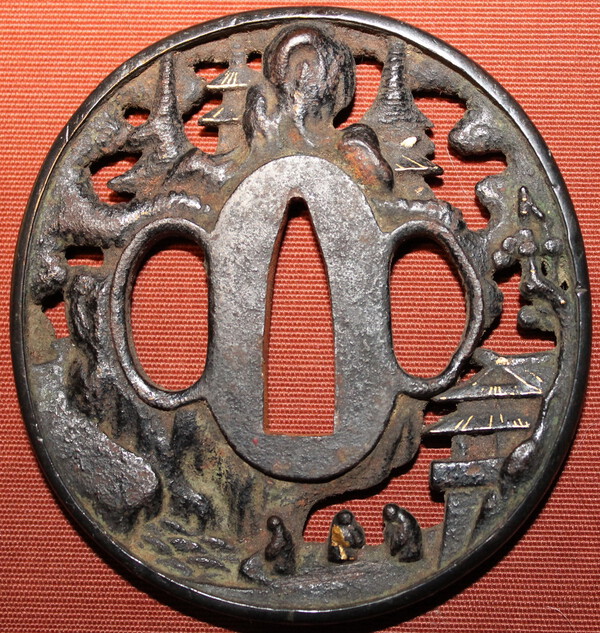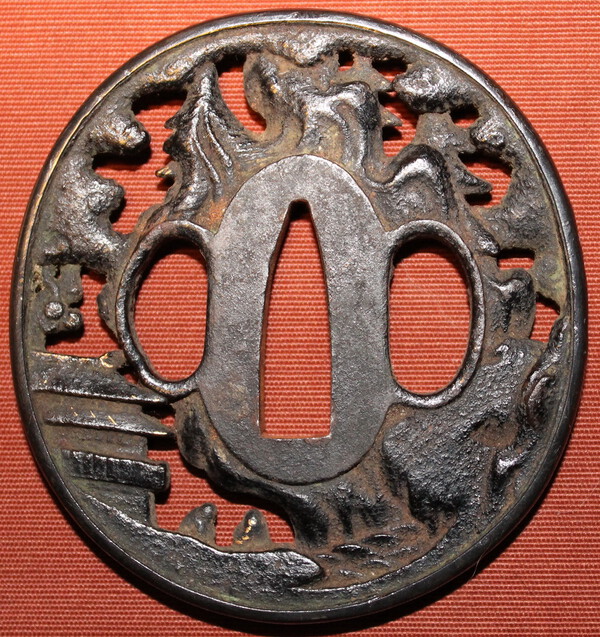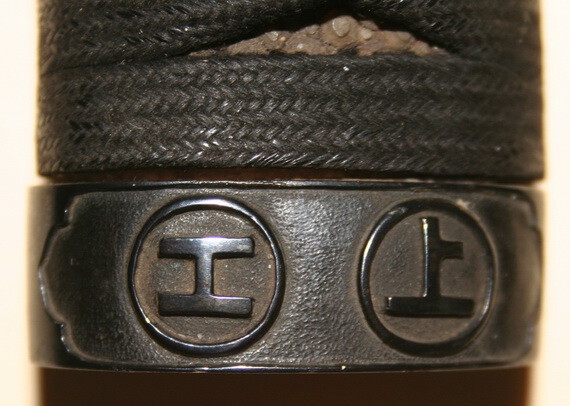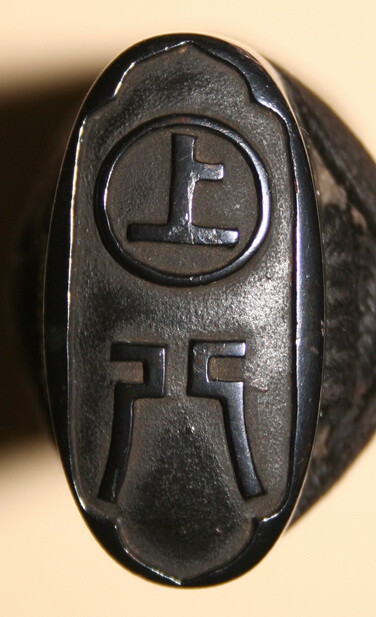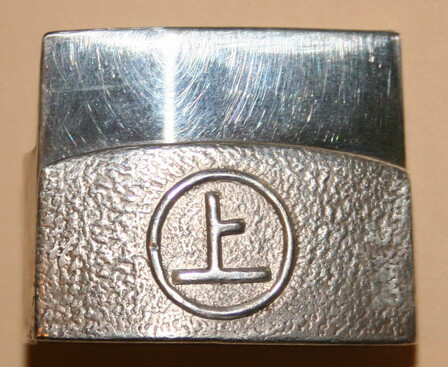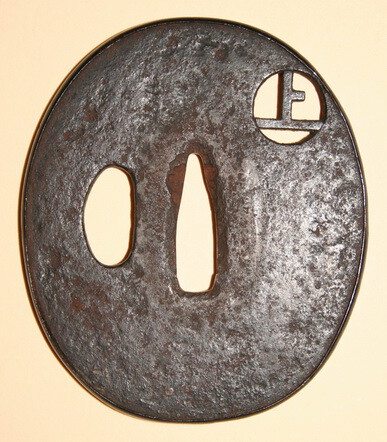-
Posts
2,745 -
Joined
-
Last visited
-
Days Won
27
Everything posted by Bazza
-

TRANSLATION HELP PLEASE - A PRESENTATION GENDAITO
Bazza replied to Bazza's topic in Translation Assistance
My apologies for the delayed response - life intervened... Thank you very much Matt and Markus for your quick reading of the presentation kanji. Having formally studied Japanese myself for a mere two years (and that a very long time ago) I appreciate how much effort goes into such mastery of the language. Incidentally Matt, I found that in rômaji the characters 練習 are rendered REN-SHÛ, not REN-SHU. Thank you too George for underscoring the meaning of ICHIDÔ. I was surprised to find the name of the person to whom the sword was presented is not inscribed. I once had a photo album of a Japanese Navy visit to US shipyards in the 1920s and despite much descriptive text the name of the album owner was not written anywhere, but the ship’s name was SHIN-I. There was a photo of Japanese Navy personnel with Milton Sills, a famous Hollywood actor of the time, and one might think that the album owner would have been in that photo and noted, but not so. As I had such difficulty researching the kanji I have been preparing some notes to summarise Matt and Markus’ contribution and I thought I would share them here for anyone’s interest. See below and my summary document attached. The first task in finding a kanji is to identify the radical to locate it in a dictionary. I missed SAKI in Nagasaki completely because the kanji on the nakago is as pictured below. It shows the GUCHI character under YAMA leading me to look for a kanji with a 6-stroke radical, whereas the correct radical was the 3-stroke YAMA, with the correct kanji for SAKI being Nelson 1426. The GUCHI character has been displaced to the left, thus leading inexperienced players astray... 崎 Other mistakes were made for similar reasons, the most simple being mistaking the two characters of ICHIDÔ as a single kanji. Grrrrrrrr... I have learnt a lot from this exercise thanks to Matt and Markus. Thanks and salutations again. Best regards, Barry Thomas. NMB discussion - kanji explanation sheet.doc -
What is known about the "Polish koshirae artist" mentioned further down in the above swordforum thread??? A "daisho" tsuba turned up here in Australia some years ago (they were exactly the same size and theme, but the gentleman buyer thought he had a real daisho at about AUD$400, I believe. A nay-sayer told the buyer that they were Polish fakes and could be bought in Poland for $5 (?????)). Same artist, I wonder... ---------------------------------------------------------------------- Tsuba made by a Polish koshirae artist. Quite good too, this is a cascading waterfall done in steel. Acid aged to a deep brown finish, very authentic looking. I love the tsuba but the piece I was going to use it on had the theme changed. Asking what I paid, $140 shipped. ---------------------------------------------------------------------- Best regards, BaZZa.
-
Having read earlier threads on the (non?) possibility of cast iron tsuba I almost hesitate to present this example to the readers as at first glance it is somewhat inconsequential. However, there are a number of reasons why I thought it might be of interest: - The metal has a rough surface that appears to be a combination of rust and sand-cast impressions - The figures in the landscape at the bottom of the front view are “blobby” and not well defined. - The tsuba has a ‘clunky’ feel to it. The above features alone are not sufficient to bring it to the attention of members, but the following I think make it of more than passing interest despite its very poor condition: - There is gold ‘onlay’ that appears to be metal and not lacquer, and with no sign of nunome grooves it is most likely mercury gilding (?). - There is what appears to be a remnant black lacquer coating. - Last but not least is a very well-fitted shibuichi fukurin, which alone drew my attention. The tsuba is 70mm x 65mm x 5mm. Whilst being very fond of tsuba they are not at all my forté, but my interest was aroused by wondering if this is indeed a cast iron tsuba, why did someone fit a very nice fukurin to it??? Any opinions??? The sword is a WW2 Australian soldier’s souvenir and has been lent to me for appraisal. It is still in the same family and honoured for its wartime association. Apart from some dark staining the blade is in remarkably good condition. It has a faint, almost ‘scratchy’ katana mei that at present seems to read OSHU JU ? HIRO. The nagasa is 63.9 cm and the sugata with little sori suggests to me a Kanbun period sword. It has an old silver foil habaki that is still nicely tight in the saya. The tsuka has nice matching shakudo fuchigashira and the menuki are iron shishi (separate thread later). The saya is of plain wood covered with leather. Compared to many of the badly damaged swords one sees this was indeed a pleasant surprise ‘out of the woodwork’ and has made for a very pleasant few hours contemplation. Best regards, BaZZa. aka Barry Thomas (Melbourne, Australia)
-
TRANSLATION HELP PLEASE - A CHALLENGING GENDAITO PRESENTATION INSCRIPTION Friends, At least, challenging for me... and I certainly hope of interest to the Board members. I have run myself ragged back and forth through Nelson’s trying to find characters. Often it’s a challenge to find the right radical, never mind the kanji. Then one has to find what the inscription means. There is one character (the last in the presentation inscription on the omote) that is so elementally simple being composed of ICHI at the top with 6 strokes below it that I simply cannot find. I’m reminded that Nelson’s “lists about 5,000 carefully selected characters...” (from the flyleaf of my 2nd printing 1975 edition) so we may expect that not all characters may be found, particularly the more obscure, archaic or little used. So I’ve all but given up and turn to the expertise of the Board. Presented in the images below is a gendaito with a tachi mei HIZEN KUNI JU YASUHIRO SAKU 肥前國住保廣作 (Hawley YAS 679). The sword is in an eclectic private collection and not presently for sale. A good friend has asked me for a translation, the smith being the easy part. He was permitted to take the images below and described the sword as - standard wartime length of around 67cm but just slightly larger proportions giving a feeling of a better than usual, quality, very well proportioned blade. - better quality Naval mounts – look to be special order/custom made. - slightly extended boshi, maybe ¼” or a little less, longer than usual. - gunome midare with ashi. - can’t remember the hada well but I think it was ko-itame but almost muji. The presentation inscription begins with a single character above the mekugiana - ZÔ (Nelson 4525, presentation, gift). Below the mekugiana is a single row of (I think) 7 characters. “I think” because the kanji press tightly one on another. The first character is our old familiar naga, or in this context I guess CHÔ - chief or headman. Then follows two rows of characters side-by-side, possibly the names of people responsible for the presentation, ending in a single character below the double row - the elusive ‘elementally simple’ character mentioned above. The last character of the left-hand row is EN, IN, -in (Nelson 928), “member, number, the one in charge”. I’ve likewise identified other individual characters but have not the slightest idea what they mean in context. The smith is well-known and a description of his personal history can be found here http://vbay.ru/iteminfo/100284837526290.htm. I saw one myself a few years ago in an auction that I might have bought were it not for a big chip. I felt it to be a better quality gendaito in a kaigunto koshirae, however there was no presentation inscription. Best regards, Barry Thomas (aka BaZZa)
-
Not raised so far is that the nature of the sword leads to the best type of polish, according to past discussions. However, having been there and done that for 50 years I lean to a polish that brings out the best in a blade, but having said that I'm still confused. OK, let me hit it. What is the primary determinant of "What makes a Japanese sword a Nihonto?". Surely it is the hamon, for a sword with a glorious hamon (suguba or midareba) is a delight to see. A sword with a glorious hada and NO HAMON is - what?? A lump of fancy steel! So it seems to me the issue comes down to this - if the hamon is important to what makes a Nihonto a Nihonto then sashikomi is the 'way'. However, if we like hada then kesho is the 'way'. Is there no in between??? I don't pretend to have any certain knowledge here and I defer to the vast experience of Chris Bowen, George Trotter, Kunitaro san, Morita san and other luminaries, but for this small-time collector and for those swords I have had polished, overall I prefer sashikomi as it espresses the glory of the hamon, the quintessential feature of Nihonto. I have a sword that was polished in "pure" sashikomi - it is brilliant to the easily seen tiniest strand of nie whisker that might otherwise have been difficult to see in kesho. The trouble is, and a continuing "niggle", is that the hada is less distinct, almost invisible in fact, compared to the before "old" polish. The hamon, whilst wishy-washy and hard to see before polish, is now crystal clear (no pun intended). So I'm not really sure if I should be disappointed or rejoicing, because the new polish has left a sword that is clearly a vast improvement on what went before condition-wise, and I'm certainly very happy with it, BUT - I lament for the diminished hada. One can go on and on, as we have done here and continue to do, but I have enjoyed this discussion immensely. Thank you all. Regards, BaZZa.
-
Alex, See viewtopic.php?f=4&t=16229 38.2mm length. Regards, Barry Thomas aka BaZZa.
-
Thank you Chris, Malcolm, Alex and Ken for your informed insights. Best regards Barry Thomas.
-
I remember John well and am saddened to see that he finally lost his battle. He did me a grand favour many years ago that I have never forgotten and we had a good correspondence for a time. One of the Good Guys amongst many who continue to inspire me daily. Rest in Peace John. Respectfully, Barry Thomas.
-
Chris, Thank you - there is the collector's blind spot!! I didn't know that. I've asked on behalf of a friend who has some swords but is new to the world of forums and suchlike. He is going to Japan in a couple days and I couldn't answer his questions so put them here. What about the export issue with (a) shinsakuto (de-registration I expect), and (b) non-sharpenable al or zn iato?? Best regards, Barry Thomas.
-
Dear Brethren, 1. Can anybody recommend a shop in Kyoto and also Tokyo to buy steel-bladed iaito?? 2. Is there any known issue with a tourist exporting a steel-bladed iaito (or alloy-bladed for that matter) from Japan on exiting the country. The person would be returning to Australia. Best regards, BaZZa.
-
G'day All. I don't think I can add much at all to this thread except in the matter of the small UE character on the back of the maedate. I haven't checked, but I'm sure this must also be a mon and I have attached photos of a wakizashi seen a few years ago with such a character appearing as if it is a mon. I guess it could also simply be a decorative element. On the Italian sword forum (now defunct??), last time I looked its opening page showed an armour in an exhibition that had the same character on the DOU, so I guess it is a mon in that context. Best regards, BaZZa.
-
Rather than "something YUKI HISA", perhaps "NORI (or something) YUKI KORE"??? BaZZa.
-
A friend of mine has a Shingunto with a tanto size hamidashi tsuba. If he sees this he will know what I mean and may comment further. BaZZa.
-
Shooting from the lip here - I can imagine a tanto being worn to the theatre by patrons, but not a katana???? Also, I meant to comment on the "sliding ashi" - I once had a tachi with handachi tosogu and one of the ashi moved freely along a contained length similar to the one Dale has shown. Regards, BaZZa.
-
Rather than a stylised fan I think it is a plectrum for a samisen or similar stringed instrument. This would certainly complement the theatre theme we seem to be seeing. http://en.wikipedia.org/wiki/Shamisen Regards, BaZZa.
-
Does Ford's example suggest the use of a matrix punch???? BaZZa.
-
The posted arrowhead is a side-notched type and looks to be more North American Indian or Neolithic European than Japanese. For some Japanese Jomon period arrowheads see for example Figure 4, items 1 – 5 in: http://www.academia.edu/1807628/The_Neo ... _Prospects The figure shows middle Jomon arrowheads from the Southern Kurile Islands. This link http://mcrocks.websitetoolbox.com/post/ ... ts-3567693 shows a large number of Japanese Jomon period arrowheads with only ONE being side-notched. The owner of the points commented: -------------------------------------------------- All of the pictured artifacts came from the same farmer's field area over a 20 year period. The arrow point styles were concurrent, and were remarkably similar over several thousand years. I found it interesting that basically no Japanese points were side-notched. I found the only one I've ever seen in Japan - and I've looked at collections at a few dozen different places in Japan. By happenstance, a university field crew excavated an area in an adjacent field. They determined the 6,000 year old date. I learned a lot from them and got ID's on some of the artifacts I'd collected. Frequently I would join the crew from a local historical museum on digs in the region. It was like getting a free graduate course in Japanese archaeology. Archaeology/anthropology was my college major. -------------------------------------------------- However, ancient Japanese spear points may have been side-notched – see http://www.metmuseum.org/toah/works-of-art/1975.268.200 which shows a Late Jomon period (ca. 1500–1000 BC) stone Spearhead. This link http://www.tnm.jp/modules/r_free_page/i ... 15&lang=en shows a small photo of Jomon period stone arrowheads that are quite unlike the posted example. Best regards, BaZZa.
-

location of Hizen sword production
Bazza replied to Peter Bleed's topic in General Nihonto Related Discussion
Peter, Without checking, I have a memory that Roger Robertshaw discusses this in his book??? Either that or he mentioned it to me in one of his visits to Oz about the finding of a Hizen kera somewhere. With regard to artillery, wikipedia addresses Armstrong cannon used in the Boshin War http://en.wikipedia.org/wiki/Saga_Domain. Anbd in the thread viewtopic.php?f=1&t=8325&start=15 our Own Dear Roger wrote: --------------------------------------------------------------- The Hizen Kaji did use foreign steel - they had a teppo factory just 25 yds down the highway from the Tadayoshi forge, and there was the cannon reverbatory factory 0.5Km back from the Nagasaki highway still in the Nagase-Machi 'area' under Hashimoto control. Interesting also how some Hizen tsuba appear very 'Namban' in nature. --------------------------------------------------------------- So a "cannon factory" would indicate cannon use and Roger's words perhaps suggest it was early Edo, but this link: ------------------------------------ http://books.google.com.au/books?id=4N0 ... CFMQ6AEwBQ ------------------------------------ says "The first reverberatory furnace (used in the making of cannon) was set up by the Saga clan (Hizen) in 1850 and was ready for use in 1852." This interesting link http://www.masuko.com/English/company/Cannon.html suggests that cannon making and use was confined to the Late Edo period, supported by a Christies sale description here http://www.christies.com/lotfinder/arms ... tails.aspx. In discussing the Shimabara Rebellion, this link http://www.uwosh.edu/home_pages/faculty ... orrea.html suggests that cannon were used in the siege with this passage "Captured prisoners revealed that no food remained in the fortress; and neither did any powder or cannon balls remain," though no mention of cannon firing during the Rebellion. Finally, antique cannon are mentioned here http://www.japaneseweapons.net/hinawajy ... nglish.htm in Seki - in any event it is a good read for the teppo people. Best regards, Barry Thomas. -

Missing Bindings Japanese Type 3 44 Sword Shin Gunto WW2
Bazza replied to phil reid's topic in Military Swords of Japan
Please tell us about the blade. Any photos of the nakago and mei, please??? Does it have a star stamp?? Regards, BaZZa. -
HAHAHA - Mariusz, absolutely no offence at all. In fact, your brain was more in gear than mine!!! SHEESH - UBU tanto in shinogi zukuri was what you meant, and I took it too liberally when I should have taken a nap... It was a long time ago that I saw this shinogi zukuri "thing" and apart from its outstanding awkwardness of sugata I cannot now remember anything about the tang. So, Mariusz' original question stands - show us an UBU shinogi tsukuri tanto, Bestests, BaZZa.
-
Mariusz, not so. I have held in my hand a shinogi zukuri tanto complete with koshirae. However, it was indeed a strange looking thing, mumei, and I guess the front end of what was left of a skinny katana. I think it was probably an alteration to give someone a cheap defensive tool, much like the yari we see mounted as tanto. It underscores the point that the only rule in collecting Nihonto is that there is an exception to every rule... Best regards, BaZZa.
-
Yes, but the 'accent' (hatsuon) in pronunciation is different. Pronunciation of tsuba in two syllables is rising on the second syllable or falling. One means a sword guard, the other spit. I know the pronunciation can sound the same, but native speakers have no trouble with it at all (of course!!). Our tutor in a language class once demonstrated this conclusively to we Western students of the language. hashi is another common one - chopsticks or a bridge depending on the accent. Bestests, BaZZa.
-

Muramasa blade for sale
Bazza replied to Hans Kondor's topic in Auctions and Online Sales or Sellers
Having seen a few of these FWIW I agree with Paul Bestests, BaZZa. -
All, The emphasis in the last sentence is mine. The botanical name notwithstanding, this sounds more like a cumquat, which is certainly highly acidic and inedible, but does make a delicious marmalade (and brandy!). I wonder about this because mandarins are a delicious citrus fruit, very flavoursome and far from the description given. Regards, BaZZa.



